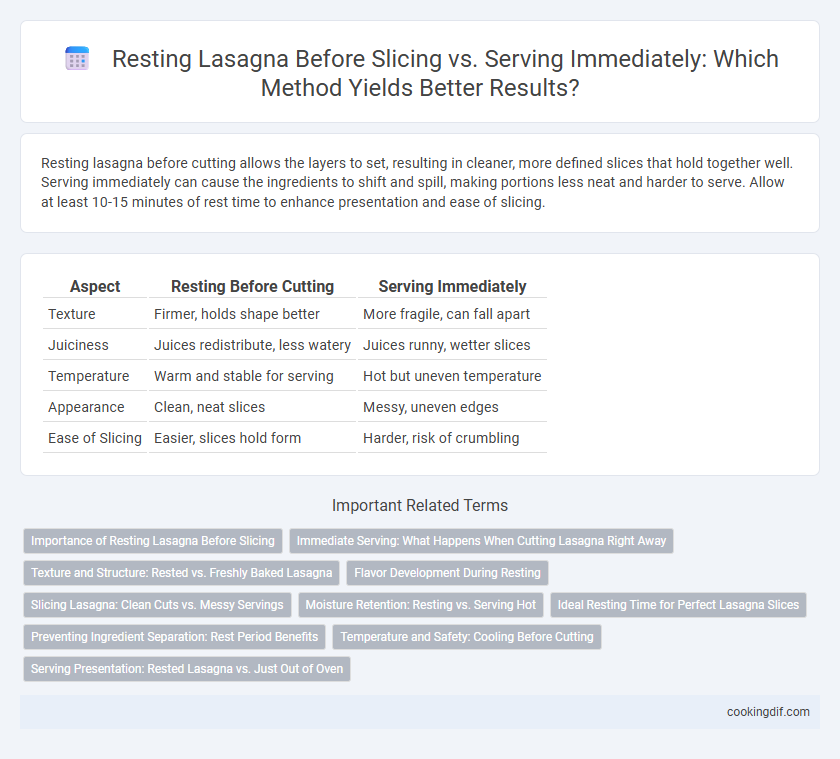Resting lasagna before cutting allows the layers to set, resulting in cleaner, more defined slices that hold together well. Serving immediately can cause the ingredients to shift and spill, making portions less neat and harder to serve. Allow at least 10-15 minutes of rest time to enhance presentation and ease of slicing.
Table of Comparison
| Aspect | Resting Before Cutting | Serving Immediately |
|---|---|---|
| Texture | Firmer, holds shape better | More fragile, can fall apart |
| Juiciness | Juices redistribute, less watery | Juices runny, wetter slices |
| Temperature | Warm and stable for serving | Hot but uneven temperature |
| Appearance | Clean, neat slices | Messy, uneven edges |
| Ease of Slicing | Easier, slices hold form | Harder, risk of crumbling |
Importance of Resting Lasagna Before Slicing
Resting lasagna for at least 15-20 minutes after baking allows the layers to firm up and the cheese to set, preventing the filling from spilling out when sliced. This crucial step enhances the texture and presentation by ensuring clean, even slices that hold their shape on the plate. Serving immediately without resting often results in a messy, uneven portion that diminishes the dish's visual appeal and eating experience.
Immediate Serving: What Happens When Cutting Lasagna Right Away
Cutting lasagna immediately after baking causes the layers to shift, resulting in a less structured and messier presentation. The hot cheese and sauce remain fluid, increasing the likelihood of spills and uneven slices. Serving right away can compromise texture and appearance, making resting essential for cohesive, clean portions.
Texture and Structure: Rested vs. Freshly Baked Lasagna
Resting lasagna for 10-15 minutes after baking enhances its texture and structure by allowing the layers to set and the cheese to firm up, resulting in cleaner, more defined slices. Serving lasagna immediately when it's freshly baked often causes the layers to be softer and more prone to sliding apart, leading to a less structured presentation. Proper resting improves the overall mouthfeel and maintains the integrity of pasta, sauce, and cheese layers for an optimal dining experience.
Flavor Development During Resting
Resting lasagna for 10 to 15 minutes after baking allows the layers to set, enhancing flavor melding and moisture retention, which results in a richer, more cohesive taste experience. Immediate cutting can cause the layers to collapse and release juices, diluting the complex flavors developed during cooking. This resting period is crucial for optimal texture and intensified seasoning.
Slicing Lasagna: Clean Cuts vs. Messy Servings
Resting lasagna for 10-15 minutes before slicing allows the layers to set, resulting in clean, well-defined cuts and preventing the filling from spilling out. Serving immediately after baking often causes the lasagna to be too soft, leading to messy portions with filling oozing onto the plate. Proper resting ensures neat servings and maintains the dish's structural integrity, enhancing presentation and ease of serving.
Moisture Retention: Resting vs. Serving Hot
Resting lasagna for 10-15 minutes after baking enhances moisture retention by allowing the layers to set, preventing the sauce from spilling out during slicing. Serving lasagna immediately when hot often results in a wetter, less cohesive dish with sauces running off the cut portions. Proper resting ensures firmer slices and a better balance of flavors and textures in each serving.
Ideal Resting Time for Perfect Lasagna Slices
Resting lasagna for 15 to 20 minutes after baking allows the layers to set, preventing the filling from spilling out and ensuring clean, uniform slices. Immediate slicing often causes the cheese and sauce to run, resulting in a messy presentation and uneven portions. Optimal resting enhances texture, making each slice firm yet tender for perfect serving.
Preventing Ingredient Separation: Rest Period Benefits
Allowing lasagna to rest for at least 15-20 minutes before slicing enhances ingredient cohesion by permitting the cheese and sauces to firm up and redistribute evenly. This resting period prevents ingredient separation during cutting, resulting in cleaner slices and a more aesthetically pleasing presentation. Serving immediately often leads to oozing sauces and toppings falling apart, compromising both texture and flavor balance.
Temperature and Safety: Cooling Before Cutting
Allowing lasagna to rest before cutting helps it reach a safer internal temperature, reducing the risk of foodborne pathogens. Cooling stabilizes the layers, preventing the filling from oozing and ensuring clean slices. Serving immediately after baking may result in uneven heat distribution, increasing the chance of burns and compromising food safety.
Serving Presentation: Rested Lasagna vs. Just Out of Oven
Rested lasagna allows the layers to set, resulting in cleaner, more defined slices for an aesthetically pleasing presentation that holds its shape on the plate. Serving immediately after baking can cause the cheese and sauce to be runnier, leading to less tidy portions and potential spilling. Optimal serving appearance relies on a minimum resting time of 10-15 minutes to enhance texture cohesion and visual appeal.
Resting before cutting vs Serving immediately for slicing Infographic

 cookingdif.com
cookingdif.com